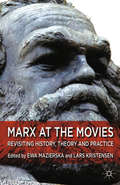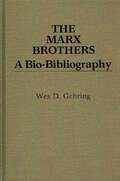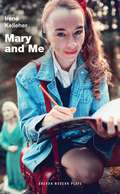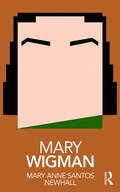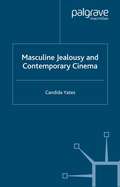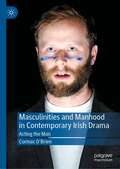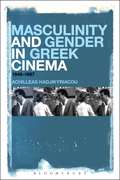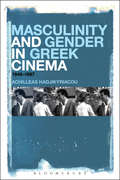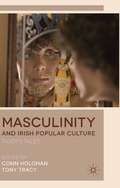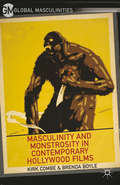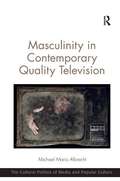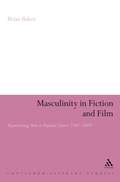- Table View
- List View
The Marvel Studios Phenomenon: Inside a Transmedia Universe
by Martin Flanagan Andrew Livingstone Mike McKennyMarvel Studios has provided some of the biggest worldwide cinematic hits of the last eight years, from Iron Man (2008) to the record-breaking The Avengers (2012), and beyond. Having announced plans to extend its production of connected texts in cinema, network and online television until at least 2028, the new aesthetic patterns brought about by Marvel's 'shared' media universe demand analysis and understanding. The Marvel Studios Phenomenon evaluates the studio's identity, as well as its status within the structures of parent Disney. In a new set of readings of key texts such as Captain America: The Winter Soldier, Guardians of the Galaxy and Agents of S.H.I.E.L.D., the thematics of superhero fiction and the role of fandom are considered. The authors identify milestones from Marvel's complex and controversial business history, allowing us to appraise its industrial status: from a comic publisher keen to exploit its intellectual property, to an independent producer, to successful subsidiary of a vast entertainment empire.
The Marvel Studios Phenomenon: Inside a Transmedia Universe
by Martin Flanagan Andrew Livingstone Mike McKennyMarvel Studios has provided some of the biggest worldwide cinematic hits of the last eight years, from Iron Man (2008) to the record-breaking The Avengers (2012), and beyond. Having announced plans to extend its production of connected texts in cinema, network and online television until at least 2028, the new aesthetic patterns brought about by Marvel's 'shared' media universe demand analysis and understanding. The Marvel Studios Phenomenon evaluates the studio's identity, as well as its status within the structures of parent Disney. In a new set of readings of key texts such as Captain America: The Winter Soldier, Guardians of the Galaxy and Agents of S.H.I.E.L.D., the thematics of superhero fiction and the role of fandom are considered. The authors identify milestones from Marvel's complex and controversial business history, allowing us to appraise its industrial status: from a comic publisher keen to exploit its intellectual property, to an independent producer, to successful subsidiary of a vast entertainment empire.
Marx at the Movies: Revisiting History, Theory and Practice
by Lars KristensenMarx and the Moving Image approaches cinema from a Marxist perspective. It argues that the supposed 'end of history', marked by the comprehensive triumph of capitalism and the 'end of cinema', calls for revisiting Marx's writings in order to analyse film theories, histories and practices.
The Marx Brothers: The Pocket Essential Guide (Pocket Essentials Ser.)
by Mark BegoWise-cracking Groucho Marx with his trademark cigar and painted on black moustache. Blonde, curly-wigged, mute Harpo, beeping his blub horn and chasing pretty girls. Rubber-faced Chico, twisting phrases into hysterical malapropisms. And handsome straight-man Zeppo Marx. Who can forget their antics in such classic comedy films as The Cocoanuts (1929), Animal Crackers (1930), Monkey Business (1931), Horse Feathers (1932), and Duck Soup (1933), which literally defined the cinematic term 1930's screwball comedy. After their first five movies became box-office hits, The Marx Brothers were bona fide movie stars. However, once they moved out to Hollywood, their film career seemed to stall. That was until Chico asked for help from one of his poker playing buddies, MGM head Irving Thalberg. Taken under Thalberg's wing, the brothers--now trimmed down to the trio of Groucho, Harpo and Chico--began the second stage of their film career. While at MGM, the kooky Marx trio reached new heights with their films including A Night At The Opera (1935), A Day At The Races (1937), Room Service (1938), At The Circus (1939), Go West (1940), The Big Store (1941), and A Night In Casablanca (1946). After World War II ended, movie tastes changed, and The Marx Brothers each went their separate ways. In 1949 however, they reunited for their final film together, Love Happy, which included a now-famous scene between Groucho and a struggling newcomer who called herself Marilyn Monroe. The Pocket Essential Marx Brothers includes a concise look at the incredible career of this unforgettable troupe, from their beginnings on the vaudeville circuit, to becoming Broadway stars, to their classic film stardom. All of the films, the co-stars, the plotlines, and all of the background tales are included. Also, the end of the film careers of the brothers is only part of the story, as Groucho, Harpo and Chico all branched out into other areas of the business on both radio and television.
The Marx Brothers: A Bio-Bibliography (Popular Culture Bio-Bibliographies)
by Wes D. GehringThis bio-bibliography was designed to present a combined biographical, critical, and bibliographical portrait of the Marx Brothers. It examines their significance in film comedy in particular, and as popular culture figures in general. The book is divided into five sections, beginning with a biography which explores the public and private sides of the Marx Brothers. The second section is concerned with the influences of the Marx Brothers as icons of anti-establishment comedy, as contributors to developments in American comedy, as early examples of saturation comedy, and as a crucial link between silent films and the talkies. Three original articles, two by Groucho and one by Gummo, comprise part three. A bibliographical essay, which assesses key reference materials and research collections, is followed by two bibliographical checklists. Appendices containing a chronological biography with a timeline, a filmography, and a selected discography complete the work.
Marxism and Film Activism: Screening Alternative Worlds
by Ewa Mazierska Lars KristensenIn Theses on Feuerbach, Marx writes, “The philosophers have only interpreted the world differently; the point is to change it.” This collection examines how filmmakers have tried to change the world by engaging in emancipatory politics through their work, and how audiences have received them. It presents a wide spectrum of case studies, covering both film and digital technology, with examples from throughout cinematic history and around the world, including Soviet Russia, Palestine, South America, and France. Discussions range from the classic Marxist cinema of Aleksandr Medvedkin, Chris Marker, and Jean-Luc Godard, to recent media such as 5 Broken Cameras (2010), the phenomena of video-blogging, and bicycle activism films.
Marxist Film Theory and Fight Club (Film Theory in Practice)
by Anna KornbluhAnna Kornbluh provides an overview of Marxist approaches to film, with particular attention to three central concepts in Marxist theory in general that have special bearing on film: “the mode of production,” “ideology,” and “mediation.” In explaining how these concepts operate and how they have been used and misused in film studies, the volume employs a case study to exemplify the practice of Marxist film theory.Fight Club is an exceptionally useful text with which to explore these three concepts because it so vividly and pedagogically engages with economic relations, ideological distortion, and opportunities for transformation. At the same time, it is a very typical film in terms of the conditions of its production, its marketing, and its popularity. Adapted from a novel by Chuck Palahniuk, the film is a contemporary classic that has lent itself to significant re-interpretation with every shift in the political economic landscape since its debut.Marxist Film Theory and Fight Club models a detailed cinematic interpretation that students can practice with other films, and furnishes a set of ideas about cinema and society that can be carried into other kinds of study, giving students tools for analyzing culture broadly defined.
Marxist Film Theory and Fight Club (Film Theory in Practice)
by Anna KornbluhAnna Kornbluh provides an overview of Marxist approaches to film, with particular attention to three central concepts in Marxist theory in general that have special bearing on film: “the mode of production,” “ideology,” and “mediation.” In explaining how these concepts operate and how they have been used and misused in film studies, the volume employs a case study to exemplify the practice of Marxist film theory.Fight Club is an exceptionally useful text with which to explore these three concepts because it so vividly and pedagogically engages with economic relations, ideological distortion, and opportunities for transformation. At the same time, it is a very typical film in terms of the conditions of its production, its marketing, and its popularity. Adapted from a novel by Chuck Palahniuk, the film is a contemporary classic that has lent itself to significant re-interpretation with every shift in the political economic landscape since its debut.Marxist Film Theory and Fight Club models a detailed cinematic interpretation that students can practice with other films, and furnishes a set of ideas about cinema and society that can be carried into other kinds of study, giving students tools for analyzing culture broadly defined.
Mary and Me (Oberon Modern Plays)
by Irene KelleherMary and Me is an acclaimed new play written & performed by Irene Kelleher, inspired by the true story of Ann Lovett, a 15-year-old girl who died giving birth beside a grotto in Granard in Co. Longford in 1984.Ireland 1986. A teenage girl begins a series of conversations with a statue of the Virgin Mary in a grotto.Inspired by a true story, Mary and Me is a compellingly original imagining of a young woman's search for understanding and meaning at a milestone in her life, and a rich and funny evocation of the Ireland of the 1980's.
Mary Wigman (Routledge Performance Practitioners)
by Mary Anne Santos NewhallThis book considers dancer, teacher, and choreographer Mary Wigman, a leading innovator in Expressionist dance whose radical explorations of movement and dance theory are credited with expanding the scope of dance as a theatrical art. Now reissued, this book combines: a full account of Wigman’s life and work an analysis of her key ideas detailed discussion of her aesthetic theories, including the use of space as an "invisible partner" and the transcendent nature of performance a commentary on her key works, including Hexentanz and The Seven Dances of Life an extensive collection of practical exercises designed to provide an understanding of Wigman’s choreographic principles and her uniquely immersive approach to dance. As a first step towards critical understanding, and as an initial exploration before going on to further, primary research, Routledge Performance Practitioners are unbeatable value for today’s student.
Mary Wigman: Modernity And Mary Wigman, 1886--1973 (Routledge Performance Practitioners)
by Mary Anne Santos NewhallThis book considers dancer, teacher, and choreographer Mary Wigman, a leading innovator in Expressionist dance whose radical explorations of movement and dance theory are credited with expanding the scope of dance as a theatrical art. Now reissued, this book combines: a full account of Wigman’s life and work an analysis of her key ideas detailed discussion of her aesthetic theories, including the use of space as an "invisible partner" and the transcendent nature of performance a commentary on her key works, including Hexentanz and The Seven Dances of Life an extensive collection of practical exercises designed to provide an understanding of Wigman’s choreographic principles and her uniquely immersive approach to dance. As a first step towards critical understanding, and as an initial exploration before going on to further, primary research, Routledge Performance Practitioners are unbeatable value for today’s student.
Masculine Jealousy and Contemporary Cinema
by C. YatesThis study provides new insights into the link between masculinity and jealousy through a study of representations of male jealousy in modern Hollywood cinema. It argues, through examples of films and their reception in the press, that male jealousy has played a key role in the psychocultural shaping of Western masculinities and male fantasy.
Masculinities and Manhood in Contemporary Irish Drama: Acting the Man
by Cormac O'BrienThis book charts the journey, in terms of both stasis and change, that masculinities and manhood have made in Irish drama, and by extension in the broader culture and society, from the 1960s to the present. Examining a diverse corpus of drama and theatre events, both mainstream and on the fringe, this study critically elaborates a seismic shift in Irish masculinities. This book argues, then, that Irish manhood has shifted from embodying and enacting post-colonial concerns of nationalism and national identity, to performing models of masculinity that are driven and moulded by the political and cultural practices of neoliberal capitalism. Masculinities and Manhood in Contemporary Irish Drama charts this shift through chapters on performing masculinity in plays set in both the Irish Republic and Northern Ireland, and through several chapters that focus on Women’s and Queer drama. It thus takes its readers on a journey: a journey that begins with an overtly patriarchal, nationalist manhood that often made direct comment on the state of the nation, and ultimately arrives at several arguably regressive forms of globalised masculinity, which are couched in misaligned notions of individualism and free-choice and that frequently perceive themselves as being in crisis.
Masculinities and the Culture of Competitive Cycling (Palgrave Studies in Masculinity, Sport and Exercise)
by Jack HardwickeDrawing on extensive ethnographic, qualitative and quantitative research, this monograph provides a novel account of masculinities in an individual sport: competitive road cycling. Chapters present varied analyses on male cyclists’ relationship with masculinity, the culture of competitive road cycling, cyclists’ attitudes toward injury management, sexual minority and women’s experiences in the sport, and autoethnographic accounts of the author’s own experiences of being involved in the sport for over ten years. The author also examines how masculinity impacts male cyclists’ attitudes towards competition, risk taking and doping practices. This book will be of interest to scholars and researchers in sports sociology, gender studies, and masculinity studies.
Masculinities in Contemporary Argentine Popular Cinema
by Carolina RochaExamines contemporary cinematic representations of Argentine masculinities, the social construction of gender, and the financing of domestic film production following Argentina's 1990 change to a neo-liberal economic model.
Masculinities in Polish, Czech and Slovak Cinema: Black Peters and Men of Marble
by Ewa MazierskaGender, especially masculinity, is a perspective rarely applied in discourses on cinema of Eastern/Central Europe. Masculinities in Polish, Czech and Slovak Cinema exposes an English-speaking audience to a large proportion of this region’s cinema that previously remained unknown, focusing on the relationship between representation of masculinity and nationality in the films of two and later three countries: Poland, Czechoslovakia/the Czech Republic and Slovakia. The objective of the book is to discuss the main types of men populating Polish, Czech and Slovak films: that of soldier, father, heterosexual and homosexual lover, against a rich political, social and cultural background. Czech, Slovak and Polish cinema appear to provide excellent material for comparison as they were produced in neighbouring countries which for over forty years endured a similar political system – state socialism.
Masculinity and Film Performance: Male Angst in Contemporary American Cinema
by D. PeberdyA lively and engaging study of on-screen and off-screen performances of masculinity, focusing on well-known male actors in American film and popular culture in the 1990s and 2000s. Peberdy examines specific social, cultural, historical and political contexts that have affected age, race, sexuality and fatherhood on screen.
Masculinity and Gender in Greek Cinema: 1949-1967
by Achilleas HadjikyriacouBetween the end of the Civil War (1949) and the colonels' military coup (1967) Greece underwent tremendous political, economic, and social transformations which influenced gender identities and relations. During the same period, Greece also witnessed an unparalleled bloom in cinema productions. Based on the recently established paradigm that cinema and popular culture viewed as social institutions can inform a historical study, Masculinity and Gender in Greek Cinema explores the relationship between Greek cinema and the society within which it was created and viewed. The book's double analytical perspective on cinema and masculinity advances both the study of cinema and popular culture as historical sources, and of masculinity and gender relations as valid categories of historical analysis. Cinema as a medium of representation, not only managed to reflect on these issues, it also provided a whole new field for their interpretation. This is the first study to explore the dramatic transformation of masculinity and gender roles, as represented in Greek cinema during the turbulent 1950s and 1960s.
Masculinity and Gender in Greek Cinema: 1949-1967
by Achilleas HadjikyriacouBetween the end of the Civil War (1949) and the colonels' military coup (1967) Greece underwent tremendous political, economic, and social transformations which influenced gender identities and relations. During the same period, Greece also witnessed an unparalleled bloom in cinema productions. Based on the recently established paradigm that cinema and popular culture viewed as social institutions can inform a historical study, Masculinity and Gender in Greek Cinema explores the relationship between Greek cinema and the society within which it was created and viewed. The book's double analytical perspective on cinema and masculinity advances both the study of cinema and popular culture as historical sources, and of masculinity and gender relations as valid categories of historical analysis. Cinema as a medium of representation, not only managed to reflect on these issues, it also provided a whole new field for their interpretation. This is the first study to explore the dramatic transformation of masculinity and gender roles, as represented in Greek cinema during the turbulent 1950s and 1960s.
Masculinity and Irish Popular Culture: Tiger's Tales
by Conn Holohan Tony TracyMasculinity and Irish Popular Culture: Tiger's Tales is an interdisciplinary collection of essays by established and emerging scholars, analysing the shifting representations of Irish men across a range of popular culture forms in the period of the Celtic Tiger and beyond.
Masculinity and Monstrosity in Contemporary Hollywood Films (Global Masculinities)
by K. Combe B. BoyleIn film, Men are good and Monsters are bad. In this book, Combe and Boyle consider the monstrous body as a metaphor for the cultural body and regard gendered behavior as a matter of performativity. Taken together, these two identity positions, manliness and monsterliness, offer a window into the workings of current American society.
Masculinity in Contemporary Quality Television (The Cultural Politics Of Media And Popular Culture Ser.)
by Michael Mario AlbrechtRecent years have seen a rise in the popularity and quantity of ’quality’ television programs, many of which featuring complicated versions of masculinity that are informed not only by the women’s movement of the sixties and seventies, but also by several decades of backlash and debate about the effects of women’s equality on men, masculinity, and the relationship between men and women. Drawing upon studies of contemporary television programs, including popular series viewed internationally such as Mad Men, The League, Hung, Breaking Bad, Louie, and Girls, this book explores the ways in which popular cultural texts address widely circulating discourses of the ostensible ’crisis of masculinity’ in contemporary culture. A rich study of masculinity and its representation in contemporary television, Masculinity in Contemporary Quality Television will appeal to scholars and students of cultural and media studies, popular culture, television studies and cultural sociology with interests in gender, masculinities, and sexuality.
Masculinity in Contemporary Quality Television (The Cultural Politics Of Media And Popular Culture Ser.)
by Michael Mario AlbrechtRecent years have seen a rise in the popularity and quantity of ’quality’ television programs, many of which featuring complicated versions of masculinity that are informed not only by the women’s movement of the sixties and seventies, but also by several decades of backlash and debate about the effects of women’s equality on men, masculinity, and the relationship between men and women. Drawing upon studies of contemporary television programs, including popular series viewed internationally such as Mad Men, The League, Hung, Breaking Bad, Louie, and Girls, this book explores the ways in which popular cultural texts address widely circulating discourses of the ostensible ’crisis of masculinity’ in contemporary culture. A rich study of masculinity and its representation in contemporary television, Masculinity in Contemporary Quality Television will appeal to scholars and students of cultural and media studies, popular culture, television studies and cultural sociology with interests in gender, masculinities, and sexuality.
Masculinity in Contemporary Science Fiction Cinema: Cyborgs, Troopers and Other Men of the Future (Library of Gender and Popular Culture)
by Marianne Kac-VergneIf science fiction stages the battle between humans and non-humans, whether alien or machine, who is elected to fight for us? In the classics of science fiction cinema, humanity is nearly always represented by a male, and until recently, a white male. Spanning landmark American films from Blade Runner to Avatar, this major new study offers the first ever analysis of masculinity in science fiction cinema. It uncovers the evolution of masculine heroes from the 1980s until the present day, and the roles played by their feminine counterparts. Considering gender alongside racial and class politics, Masculinity in Contemporary Science Fiction Cinema also brilliantly situates filmic examples within the broader culture.In view of its largely young male audience, what masculine norms and models of behaviour are promoted by science fiction films? During the 1980s, the genre helped to redefine white masculinity in America as both powerful and victimised. Heroes embodied Reagan-era hypermasculinity, but owed their resolve to earlier traumas inflicted by greedy and technology-obsessed elites, a critique of the decade's materialism. By the 1990s, the emotional terrain available to male characters was expanded, even witnessing the humanisation of the Terminator, and black characters entered the stage. At the same time, the world of science fiction became increasingly sanitised, moving away from the dystopias of the 1980s. Can science fiction call into question the privileged position of whiteness as the invisible and universal norm for the whole of humanity? In many ways, science fiction challenges the status quo, offering an imaginary space where identities are renegotiated. Working-class heroes fight corrupt corporations (Escape from New York or RoboCop), powerful heroines battle for survival (Alien), and cyborgs morph from one sex to another (Terminator 2). Considering these alternative visions, the book highlights the tensions inherent to science fiction as a genre. It is indispensable for understanding science fiction and its role in contemporary cultural politics.
Masculinity in Fiction and Film: Representing men in popular genres, 1945-2000 (Continuum Literary Studies)
by Brian BakerThis book looks at a wide range of fiction and film texts, from the 1950s to the present, in order to analyse the ways in which masculinity has been represented in popular culture in Britain and the United States. It covers numerous genres, including spy fiction, science fiction, the Western and police thrillers. Each chapter focuses on key forms of masculinity found in each genre, such as the 'double agent', the 'rogue cop' and the 'citizen-soldier'.Brian Baker takes a broad, contextual approach, placing a detailed discussion of key texts and issues concerning masculinity in their historical and cultural context. Written in a clear, accessible way, it explores the changing representation of men over the last fifty years.

